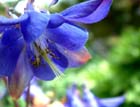Late summer flowers
Mark Griffiths loves Autumn flowers and Indian summers


It's a time of year that can leave one with a slight catch in the throat, or take the breath away. Freshly kitted out after its summer moult, the robin has started singing again a new tune, wistful and hesitant, which quietly says it all.
The lawns are dewy, and broody garden spiders set about their high-rise construction work with touching trust in the permanence of dahlias that are already nearing their finish. Long and sharply oblique, the morning shadows are cast by a sky that seems unusually high and contains only the vapour trail of a solitary homebound jet. It's neither summer nor autumn, but something brief and precious between them, the year inspecting its watch and deciding to spend just a little longer on the beach before packing up and heading indoors.
I used to celebrate it by heading for New England, to coincide with the flowering of the true Indian summer. Lining the route back from Maine to Manhattan, America's late flowers would fill me with a sense of life resumed, and of new intrigues in store.
Twenty years on, the very species I'd to fly west to see are popular again over here. With daisies such as Aster and Rudbeckia and grasses such as Andropogon and Panicum, we now have a horticultural repertoire to complement Old England's native late-summer beauty, and they're not all American. The fondant pinks and the grenadine reds of Schizostylis hail from South Africa; likewise, the genus that currently has me spellbound: Kniphofia, or red-hot poker.
While our new place in Oxford is sorted out, we're staying not far away at Pettifers, home of Gina Price and one of the finest English country gardens of the new century. As strokes of good fortune go, it's the plantsman's equivalent of handing an art critic the keys to the Courtauld while his Camberwell flat is being knocked into shape.
Although Gina's garden is a masterpiece at any time (and beautifully managed by her gardener, Polly Stevens), it nears its climax now, in autumn's prelude. Ornamental grasses and prairie daisies play large parts, forming clouds and constellations of soft tones and textures heart-stoppingly lovely early in the day, while mist still wreathes the slopes and dells of Lower Wardington.
But Mrs Price is a Fauvist as well as an Impressionist. As the sun peaks, a different cast of plants steps forward. Chief among them are the pokers, some red hot, others as cool as lemon sorbet, but all given something clever and collaborative to do. The tangerine drumsticks of Kniphofia rooperi, for example, are paired with the midnight-blue monkshood Aconitum Arendsii, a colour contrast that sounds like a clash, but which resolves in the eye to produce instant elation.
Exquisite houses, the beauty of Nature, and how to get the most from your life, straight to your inbox.
A calmer variation from this same palette is a border where Kniphofia Bees' Sunset stands like a burnished sentry line between mauve Michaelmas daisies and the lilac spires of Veronicastrum virginicum Fascination.
Sometimes, Gina needs nothing more than an ornamental grass to turn Kniphofia from a poke in the eye into a perfectly framed picture. For example, Kniphofia Buttercup, small and with pure citron wands, becomes a luminescent bouquet when backed by a haze of Korean feather grass, Calamagrostis brachy-tricha.
‘And I'm terribly happy,' she tells me, ‘about two fairly new cultivars that I've recently brought together. Kniphofia Safranvogel is slim, with delicate apricot or salmon flowers. It's wonderful beside Penni-setum thunbergii Red Buttons, a grass with fine green clumps and silky red-brown flowerheads that looks like a miniature reedmace.'
Although she's right to feel happy about this duet, my favourite of all her pairings involves two better-known plants: Kniphofia Tawny King and Calamagrostis Karl Foerster. The grass's flowerheads have faded to a warm and wheaten tan and the pokers are a radiant mix of ivory, saffron and cinnabar. Together, they capture the magic of this golden in-between season where endings and beginnings meet in triumph.
Country Life is unlike any other magazine: the only glossy weekly on the newsstand and the only magazine that has been guest-edited by His Majesty The King not once, but twice. It is a celebration of modern rural life and all its diverse joys and pleasures — that was first published in Queen Victoria's Diamond Jubilee year. Our eclectic mixture of witty and informative content — from the most up-to-date property news and commentary and a coveted glimpse inside some of the UK's best houses and gardens, to gardening, the arts and interior design, written by experts in their field — still cannot be found in print or online, anywhere else.
